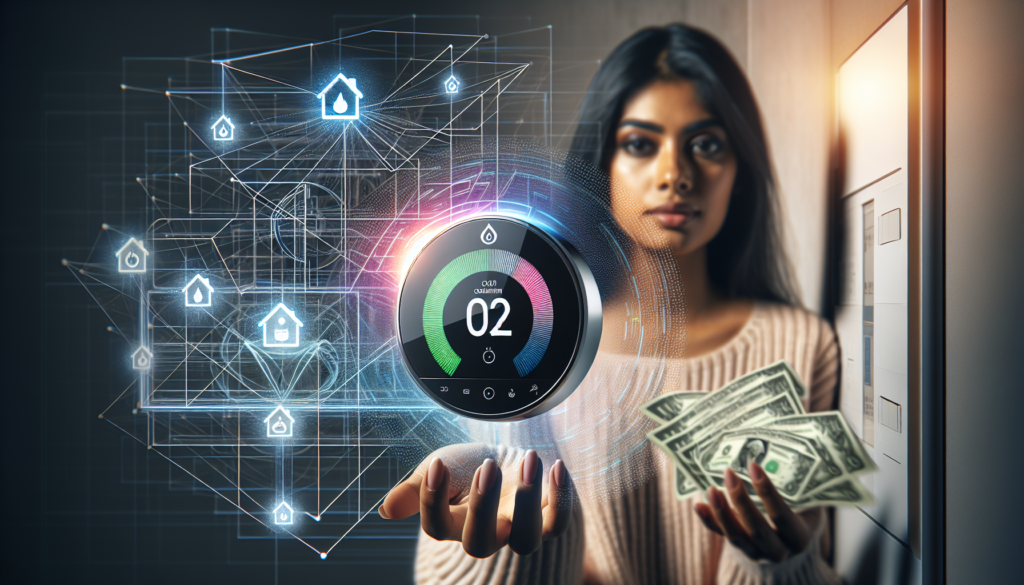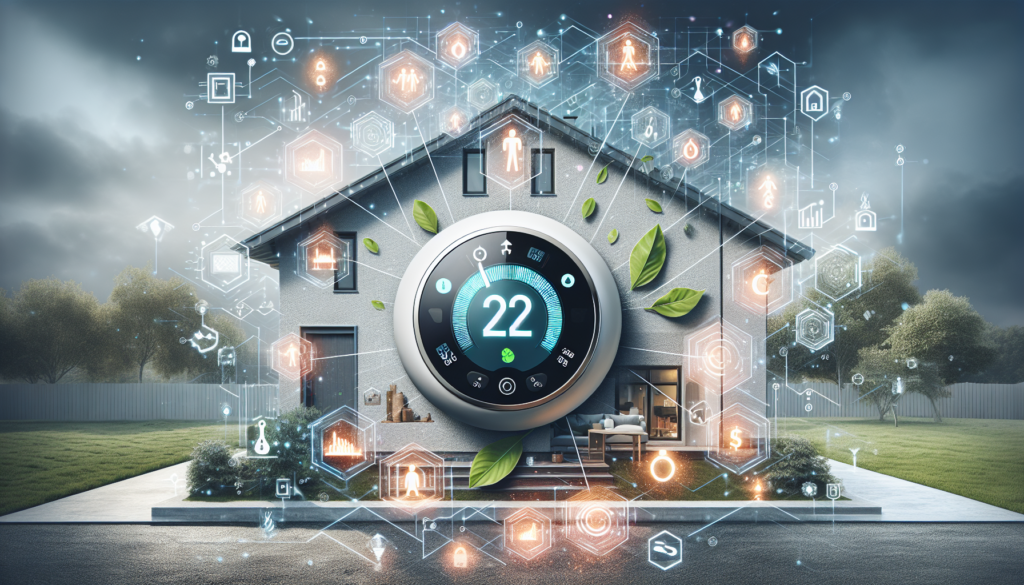Imagine having a thermostat that knows exactly when you’re home and when you’re not, adjusting the temperature accordingly to optimize energy efficiency and comfort. That’s where geofencing and occupancy sensors come into play in smart thermostats. Geofencing technology allows the thermostat to track your location using your smartphone, ensuring that your home is always at the perfect temperature when you arrive. Meanwhile, occupancy sensors detect movement in different rooms, allowing the thermostat to adjust the temperature in occupied areas while saving energy in unoccupied spaces. Together, these innovative features transform the way we control and manage our home’s climate, providing convenience, savings, and environmental friendliness all at once. Geofencing and occupancy sensors play crucial roles in enhancing the functionality and efficiency of smart thermostats. These advanced technologies offer several benefits, including energy optimization, convenience, and cost savings, ultimately enhancing the overall experience of using a smart thermostat. In this article, we will delve into the definitions, benefits, implementation, use cases, challenges, and limitations of geofencing and occupancy sensors in smart thermostats.

Definition of Geofencing
Geofencing refers to the use of virtual boundaries or geographic limits to trigger certain actions or events when a user enters or exits a designated area. In the context of smart thermostats, geofencing allows for automatic adjustment of temperature settings based on the user’s location. By utilizing the capabilities of GPS or location tracking technologies, geofencing ensures that the thermostat adjusts itself to an optimal temperature when the user is within a defined boundary.
Definition of Occupancy Sensors
Occupancy sensors, also known as motion sensors or presence detectors, are devices that detect the presence or absence of people within a space. In the realm of smart thermostats, occupancy sensors play a crucial role in determining occupancy status and adjusting temperature settings accordingly. These sensors utilize different technologies such as passive infrared (PIR) sensors, ultrasonic sensors, or a combination of both to accurately detect human presence and occupancy levels in a room or building.

Overview of Smart Thermostats
Before delving deeper into the roles of geofencing and occupancy sensors, it is essential to have a broad understanding of smart thermostats. Unlike traditional thermostats, smart thermostats are equipped with advanced features and connectivity that allow for remote control, scheduling, and automated temperature adjustments. These thermostats can learn user preferences, optimize energy usage, and integrate with other smart devices or systems within a home or building.
Benefits of Geofencing in Smart Thermostats
Geofencing brings numerous benefits to the functionality and efficiency of smart thermostats. Let’s explore some of these benefits in detail.
Energy Efficiency
One of the primary benefits of geofencing is its ability to promote energy efficiency. By automatically adjusting temperature settings based on the user’s location, smart thermostats can ensure that energy is not wasted on heating or cooling an unoccupied space. When the user leaves the designated geofence boundary, the thermostat can set the temperature to an energy-saving mode, conserving energy and reducing utility bills.
Convenience
Geofencing also adds a layer of convenience to the use of smart thermostats. Instead of manually adjusting the temperature settings every time you enter or leave your home, geofencing enables the thermostat to do it automatically. This feature eliminates the need for constant monitoring and ensures that your home is always at the desired temperature when you arrive, without any effort on your part.
Cost Savings
Another significant benefit of geofencing is the potential for cost savings. By optimizing energy usage and reducing unnecessary heating or cooling, smart thermostats with geofencing capabilities can lead to substantial cost savings on utility bills over time. These savings can add up, making geofencing a valuable feature for budget-conscious users.

Implementation and Functionality of Geofencing
To understand how geofencing works in smart thermostats, let’s explore its implementation, functionality, and customization options.
How Geofencing Works
Geofencing relies on the use of GPS or location tracking technologies to establish virtual boundaries for triggering temperature adjustments. When a user’s smartphone or other authorized mobile device enters or exits the defined geofence boundary, the thermostat receives a signal and adjusts the temperature settings accordingly. Some smart thermostats offer customizable geofence sizes, allowing users to define the proximity at which temperature adjustments should occur.
Integration with Smart Devices
Smart thermostats with geofencing capabilities can integrate with other smart devices or systems within a home or building. For example, when the geofence boundary detects the user’s arrival, it can not only adjust the temperature settings but also activate other connected devices, such as turning on lights, unlocking doors, or even playing personalized welcome messages. This integration enhances the overall smart home experience and creates a seamless environment based on the user’s presence.
Customization and Settings
Geofencing in smart thermostats often comes with customization options and settings to meet individual preferences and needs. Users can define specific temperature ranges, comfort presets, or schedules associated with entering or leaving the geofence boundary. Additionally, some smart thermostats allow for multiple users to have their own geofencing parameters, ensuring that everyone in the household enjoys personalized climate control.
Use Cases and Examples of Geofencing
Geofencing in smart thermostats has various use cases and can be applied in different scenarios. Let’s explore some practical examples.
Automatic Temperature Adjustment
Imagine coming home after a long day at work to find your home already at the perfect temperature. Geofencing enables smart thermostats to automatically adjust the temperature settings when you enter the defined geofence boundary, ensuring optimal comfort upon your arrival. This eliminates the need to manually adjust the thermostat and allows you to enjoy a cozy environment without any effort.
Smart Home Automation
Geofencing can be integrated with other smart home devices to automate various tasks based on your presence. For example, when the thermostat detects that you’re leaving your home, it can trigger other devices to switch off or enter an energy-saving mode. This integration enhances the overall efficiency of your home automation system and promotes energy conservation.
Enhanced Security and Privacy
Geofencing can also enhance the security and privacy aspects of your home. By integrating the geofencing feature with your home security system, you can receive notifications or alerts if someone enters or exits the geofence boundary when you’re away. This feature adds an extra layer of protection and helps you stay informed about any unexpected movements in your home.

Challenges and Limitations of Geofencing
While geofencing offers numerous benefits, it is important to consider its challenges and limitations.
Accuracy and Reliability
Geofencing relies on GPS or location tracking technologies, which may not always provide accurate or reliable results. Factors like signal strength, device compatibility, or environmental conditions can sometimes affect the accuracy of location detection. This could lead to occasional inconsistencies in adjusting temperature settings or delayed responses based on the user’s location.
Privacy Concerns
Implementing geofencing in smart thermostats requires the collection and processing of user location data. This may raise privacy concerns for some users, as location information may be shared with third-party service providers or cloud platforms. It is crucial for manufacturers and developers to prioritize user privacy and provide transparent information about data collection and usage.
Dependency on Mobile Devices
Geofencing heavily relies on the presence and availability of a user’s mobile device. If a user forgets or loses their smartphone or other authorized devices, the thermostat may fail to accurately detect their presence or absence. This dependency on mobile devices can sometimes limit the effectiveness of geofencing as a standalone feature.
Benefits of Occupancy Sensors in Smart Thermostats
In addition to geofencing, occupancy sensors bring their own set of benefits to smart thermostats. Let’s explore these benefits in detail.
Energy Optimization
Occupancy sensors play a critical role in optimizing energy usage in smart thermostats. These sensors can accurately detect human presence or occupancy levels in a room or building and adjust the temperature settings accordingly. By avoiding unnecessary heating or cooling of unoccupied spaces, occupancy sensors contribute to significant energy savings and promote environmental sustainability.
Increased Comfort
Occupancy sensors enhance the comfort levels in a home or building by ensuring that temperature settings align with the actual occupancy. Instead of relying solely on pre-set schedules or timers, smart thermostats with occupancy sensors can dynamically adjust the temperature based on real-time occupancy information. This feature ensures that the temperature is comfortable and appropriate for the people present in the space at any given time.
Improved Indoor Air Quality
Incorporating occupancy sensors into smart thermostats can also lead to improved indoor air quality. By detecting human presence or occupancy levels, these sensors can trigger ventilation systems or air purifiers to circulate or filter the air more efficiently when people are present. This helps maintain a healthier indoor environment by reducing the accumulation of pollutants or allergens and promoting better air quality for occupants.

Types and Capabilities of Occupancy Sensors
To understand how occupancy sensors function within smart thermostats, let’s explore the different types and capabilities of these sensors.
Passive Infrared (PIR) Sensors
Passive Infrared (PIR) sensors are the most common type of occupancy sensors used in smart thermostats. These sensors detect human presence based on changes in infrared radiation emitted by the human body. When a person moves within the sensor’s field of view, the PIR sensor detects the change in heat patterns and triggers the thermostat to adjust temperature settings accordingly. PIR sensors are effective at detecting occupancy but may not be as accurate in distinguishing between individuals or tracking movement patterns within a space.
Ultrasonic Sensors
Ultrasonic sensors utilize ultrasonic waves to detect occupancy levels within a room or building. These sensors emit high-frequency sound waves and analyze the reflections or echoes to determine if someone is present. Ultrasonic sensors are effective at detecting the presence of occupants and can provide accurate information even when people are stationary or not within the direct line of sight. However, they may require additional installation considerations and can be more sensitive to background noise or airflow.
Dual Technology Sensors
Dual technology sensors combine the capabilities of PIR and ultrasonic sensors to enhance detection accuracy and reduce false triggers. These sensors utilize both infrared radiation and ultrasonic waves to determine occupancy levels within a space. By incorporating multiple detection mechanisms, dual technology sensors can provide more reliable and accurate occupancy information to smart thermostats, ensuring effective temperature adjustments based on the actual presence of occupants.
Integration and Functionality of Occupancy Sensors
Occupancy sensors in smart thermostats offer integration and functionality that can greatly enhance their effectiveness. Let’s explore these aspects in more detail.
Communication with Smart Thermostats
Occupancy sensors need to communicate seamlessly with smart thermostats to enable accurate and timely temperature adjustments. Through wireless protocols such as Zigbee or Wi-Fi, occupancy sensors can transmit occupancy data to the thermostat, which then processes the information and adjusts temperature settings accordingly. This communication ensures that the thermostat receives real-time occupancy information and can optimize heating or cooling based on the actual presence of occupants.
Monitoring and Data Collection
Occupancy sensors also provide valuable monitoring and data collection capabilities for smart thermostats. These sensors can collect occupancy data, including the number of people present, movement patterns, or duration of occupancy. By analyzing this data, smart thermostats can adapt and optimize temperature settings to align with occupancy patterns, resulting in further energy savings and improved comfort.
Adaptive Learning
Smart thermostats with occupancy sensors often incorporate adaptive learning algorithms to further enhance their functionality. These algorithms analyze occupancy data over time, identify patterns, and learn the occupants’ preferences and routines. By understanding the occupants’ behavior, the thermostat can proactively adjust temperature settings to align with their preferences and optimize energy usage without the need for manual intervention.
Use Cases and Examples of Occupancy Sensors
Occupancy sensors in smart thermostats have a wide range of practical use cases and can be applied in various scenarios. Let’s explore some examples.
Optimized Zoning and Scheduling
By accurately detecting occupancy levels in different zones or rooms within a home or building, occupancy sensors enable smart thermostats to create customized temperature zones and schedules. For example, if a particular room is unoccupied for an extended time, the thermostat can adjust the temperature in that zone to an energy-saving mode. This optimization of zoning and scheduling ensures that energy is not wasted on heating or cooling unoccupied spaces, resulting in significant energy savings.
Automated Ventilation Control
Occupancy sensors can also be utilized to automate ventilation systems in conjunction with smart thermostats. When occupancy sensors detect the presence of occupants in a particular space, they can trigger ventilation systems to increase airflow, providing fresh air and maintaining optimal indoor air quality. This automated ventilation control helps create a healthier environment, reduces the buildup of pollutants, and enhances comfort levels for occupants.
Efficient Lighting Control
Integrating occupancy sensors with smart thermostats can also enable efficient lighting control within a space. By detecting occupancy levels, these sensors can trigger the lighting system to turn on or off based on the presence or absence of occupants. This automation eliminates the need for manual light switches and ensures that lights are only utilized when needed, resulting in additional energy savings and convenience.
Conclusion
Geofencing and occupancy sensors play vital roles in the functionality and efficiency of smart thermostats. Geofencing enables automatic temperature adjustments based on the user’s location, promoting energy efficiency, convenience, and cost savings. Occupancy sensors accurately detect human presence and occupancy levels, optimizing energy usage, increasing comfort, and improving indoor air quality. As these technologies continue to evolve, the integration of geofencing and occupancy sensors with smart thermostats will play an increasingly significant role in creating smart, sustainable, and comfortable living environments.










